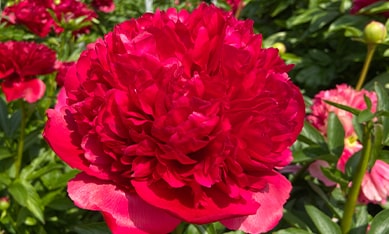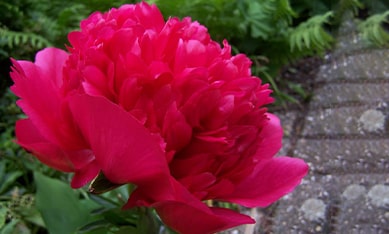Botanical Peonies
Botanical Peonies
Last Reviews
The Basics of Growing Botanical Peonies: Tips and Tricks for New Gardeners
Botanical peonies, with their large, colorful blooms and lush foliage, are a stunning addition to any garden. There are a few helpful tips and tricks to remember for new gardeners who want to grow botanical peonies.
Choose the right variety - Botanical peonies are available in a wide range of colors and sizes. Consider the climate in your area as well as the amount of sunlight your garden receives when deciding which ones to purchase. Popular cultivars include the Fernleaf Peony, Japanese Peony, and Tree Peony.
Plant in the right season - Botanical peonies should be planted in the fall, ideally in September or October. This gives the plant enough time to establish its roots before the winter months.
Prepare the soil - Botanical peonies prefer well-drained soil that is rich in organic matter. Before planting, amend your soil with compost or well-rotted manure to provide the plant with the nutrients it needs to thrive.
Finding the Perfect Spot: Where to Plant Botanical Peonies for Optimal Growth
When it comes to growing botanical peonies, choosing the right location is crucial. Here are a few tips to help you find the appropriate spot for your plants:
Look for a spot with full sun - Botanical peonies require at least six hours of direct sunlight per day. Choose a location that gets full sun throughout the day.
Avoid areas with standing water - Botanical peonies do not like wet feet and can suffer from root rot if the soil is constantly wet. Avoid planting in areas where water tends to pool, and make sure the soil is well-drained.
Provide some protection from the wind - Botanical peonies can be fragile, and their large blooms can be damaged by strong winds. Plant your peonies near a fence or wall for some protection, or use stakes to support the plants if necessary.
Planting Botanical Peonies: Tips and Tricks for a Successful Garden
Planting botanical peonies is a simple process, but there are a few things you can do to make your garden a success. Here are some pointers to remember:
Dig a hole twice the width of the plants root ball - this will allow the roots to spread out and establish themselves in the soil.
Plant the peony at the right depth - Botanical peonies should be planted with the eyes (buds) facing upwards, and the top of the root ball should be no more than two inches below the soil surface.
Water regularly - Peonies require regular watering, especially during the first few weeks after planting. Water deeply once a week, or more often if the soil is dry.
Caring for Botanical Peonies: A Comprehensive Guide to Maintaining Healthy Plants
Botanical peonies are some of the most aesthetically pleasing and sought-after flowers in the world. They are known for their large, fragrant blooms and lush green foliage. But like any other plant, they require proper care and maintenance to thrive. In this comprehensive guide, we will provide you with everything you need to know to keep your botanical peonies healthy and blooming year after year.
When planting botanical peonies, it is wise to choose a location that receives plenty of sunlight and has well-drained soil. Peonies prefer neutral to slightly acidic soil and do not do well in soil that is too alkaline. It is also imperative to plant them at the correct depth, with the eyes (buds) of the plant just below the soil surface.
Botanical peonies require regular watering, especially during hot, dry weather. However, they do not like sitting in wet soil, so it is imperative to make sure the soil is well-drained. A helpful rule of thumb is to water deeply once a week, rather than giving them some water every day.
Peonies require fertilization once or twice a year, in the spring and/or fall. Use a balanced fertilizer, such as a 10-10-10 formula, and apply it according to the manufacturers instructions.
Botanical peonies do not require much pruning, but it is wise to remove any dead or diseased foliage in the fall. You can also remove spent blooms after they have faded, but this is not necessary for the health of the plant.
Propagating Botanical Peonies: How to Expand Your Collection of These Beautiful Blooms
Botanical peonies are a beautiful addition to any garden, with large, showy flowers that are simply stunning. If you already adore these lovely plants, you might be wondering how you can expand your collection. Growing botanical peonies is, fortunately, easier than you might think.
The most ideal time to propagate botanical peonies is in the fall, after the plant has finished blooming. This will give the plant time to establish itself before the next growing season.
When spreading botanical peonies, it is vital to use healthy plants. Look for disease-free plants with strong, healthy roots.
Dividing the plant is the most common method of propagating botanical peonies. Dig up the plant carefully and gently separate the roots into several smaller clumps. Every clump should have three to five eyes, or buds.
Plant the Divisions: Once youve divided the plant, its time to plant the new divisions. Choose a spot in your garden that gets plenty of sunlight and has well-draining soil. Dig a hole for each division and place the plant in the hole, making sure that the eyes are facing upwards. Cover the roots with soil and water well.
Care for Your New Plants: After planting, it's important to care for your new botanical peonies properly. Water the plants regularly, but be careful not to overwater. Fertilize the plants in the spring and fall with a balanced fertilizer.
Your Guide to Buying Botanical Peonies: Tips and Advice for Choosing the Perfect Plants
Are you considering adding botanical peonies to your garden or home? Look no further than this comprehensive guide for all the tips and advice you need to choose the perfect plants.
Botanical peonies are not just stunningly beautiful, but they also offer several benefits to the gardener. These flowers are hardy and can thrive in a range of climates and soils. They are also low-maintenance and require minimal care once established. Additionally, they attract pollinators such as bees and butterflies, making them a great choice for eco-conscious gardeners.
When purchasing botanical peonies, it is important to look for healthy plants with strong stems and healthy leaves. Avoid any plants with yellowing or wilting leaves, as this may indicate disease or other issues. It is also essential to consider the variety and color of the peony, as some varieties may grow better in certain climates or soil conditions.
Botanical peonies come in a range of colors, from vibrant pinks and reds to soft pastels and whites. Consider the color of the flowers and how they will complement your home or garden decor. The foliage of peonies is also beautiful and can add texture and interest to any planting scheme.













